I needed to get out fishing. A February thaw was taking a bite out of the Northern Michigan snowpack. A wide sheet of water, recently roof-snow, hung in front of the office windows, glittering like a million falling diamonds in the unseasonable afternoon sun. A small river had cut a ravine through the hard-packed ice in the parking lot, and twisted into a dangerous-looking vortex over the storm drain.
Just going fishing wasn’t going to cut it. I’d been fishing plenty that winter. In Michigan, reliable aquifers keep hundreds of miles of trout and steelhead water from freezing. I love these rivers, and those fish, but I’d had enough of postholing in deep snow, shivering in drift boats, and biting ice out of snake guides. The warm weather was vibrating a different chord in my chest.
I discussed this problem with my fishing-buddy-colleague Erick across the cubicle divider. He was of the same mind. We’d had enough; we were ready for some warm water fishing, we decided, in a bitching-about-the-weather kind of way. But then I remembered.
I knew a spot.
A spot near — let’s say — a Lake Michigan rivermouth with an upstream power plant. It had been shared with me when I was new to the state, a few years earlier, by some generous non-fly fishing friends who had no interest in trout or steelhead, but had a serious interest in walleyes and smallmouth bass. And in the time-travel feeling of fishing artificially-open water in mid-winter. We caught fish that day: smallmouth bass and walleyes. Some big ones. We stood in slushy water, dodged icebergs, and caught summertime fish.
So the next afternoon, with a high in the mid-40s, Erick and I sneaked out of work early, drove west, and hiked a mile to the lakeshore. We broke a half-inch of ice over a foot of water the entire way, in the bottom of a drainage ditch, which we were obliged to follow by the power company’s razorwire security fence. Not as hard on the heart as postholing in deep snow, but a lot harder on the shins.
But the wind was coming off the lake and smelled like open water. The sun was warm on our faces, and we had been dreaming of smallies since last summer. We carried eight weights, intermediate sinking lines, and each a box of Murdich minnows and deceivers, unweighted, so as not to drag on the bottom when fished slowly.
When we finally reached the edge of the cattail marsh that marked the shoreline, we were amazed to find dry sand and a distant surf, chocolate-colored with the wind’s churning. We’d heard the lake level was low this year; evidently, it was low enough to peel back from a hundred yards of brand new beach.
We crunched along this thawing, stinking, old lakebottom on a blanket of stranded shellfish — mostly invasive zebras and quaggas — and carefully stepped around a variety of dead fish, from salmon to carp, and one eye-watering deer carcass. A winter’s worth of detritus, frozen and preserved, until now.
When we reached the rivermouth, where the warm water was supposed to be pouring into the lake, we didn’t even unhook our flies from the keepers. It was stagnant -- the power plant not generating, we guessed -- and low. The gravel bottom was visible all the way across. I stood there for a while, looking, while Erick wandered toward the surf.

“Hey, was that a fish?” he hollered, looking at the rollers about forty yards out. I followed his gaze and saw a splash, as if a passing aircraft had dropped a bowling ball.
It was indeed a fish. There were dozens of them, breaching like whales in the muddy waves for reasons known only to them. Carp, we discovered, when one jumped a just in front of us, its gold scales glinting.
If it weren’t for the snowy shoreline behind us, the ice and slush piled along the surf line, and the knowledge that it was carp cruising this beach, we might have been on any salt coast, looking at snook, or bluefish, jacks. Seagulls and terns whirled above us, inelegant in the wind.
But we’d messed with these Lake Huron carp the summer before. Messed around with frustratingly-technical sight casting in murky water, with fish that won't move more than a few inches to eat a fly, and only if it’s the right fly, sinking at the right rate, and only some of the time. Blind-casting into a group of them never works.
But they were right there.
Our fly boxes full of minnow patterns would be no help. We needed something that would sink. Something that would get down through the chop and lay on the bottom, where a carp might see them. I shouted aloud when I found a pair of crusty lead-eyed rabbit-strip crayfish in the bottom of my pack, among the twisted tippet tag-ends, pinched split shot, and pine needles.
So we tied them on and carefully double-hauled them into the wind.
It worked right away. Erick was slowly hopping his fly in, short strips, when it stopped hard. Whatever had it then chugged towards open water like a steam locomotive. He turned it just as his backing knot was clicking through the rod guides, and slowly worked it back into the surf, where we confirmed it was not just a carp, but a monstrous carp.
Like all big carp, it was tough to wrangle: Their tails are not stiff enough to grab and their bodies are round and hard and don't drape over your hands. Erick looked like a little kid trying to palm a slimy, writhing football, while muddy swells slapped into his thighs, splashing up into his face. I stood back and watched, grinning.

He resorted to hugging the fish to his waders — which swallowed a fair amount of slimy water in the effort — to get the hook out. Out of, notably, the carp’s mouth. We’d been suspicious that the fish was hooked in the dorsal fin or the tail. But no: the fish had committed and ate that fly with confidence.
And they kept eating. We’d feel resistance, strip set, stretch backing, grapple, unhook, release. Rest bicep and repeat. For some reason these carp were eating our flies as if they’d never seen a crayfish before. As if they were starving, maybe, though their bulk certainly implied a steady diet. Mixed in we also caught a couple freshwater drum — a first for both of us — including one giant that had to be nearly twenty pounds. It turned sideways and power-circled, like a colossal bluegill, Erick unable to move it until it tired itself out. n
When the sun dipped behind horizon, the fish quit, and the wind shifted northward and cold. We started our walk back through the marsh. The ice we’d broken on the way back in was already regrowing. The thaw was ending; winter was back. We were slimed, toes and fingers freezing. It would be months before we’d have another shot at smallmouth bass.
But we weren’t complaining.




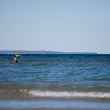


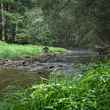



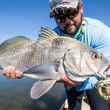
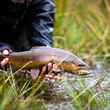



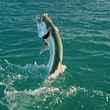




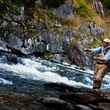




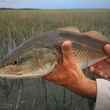



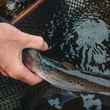

Comments
Joe replied on Permalink
That's not a carp in the picture, That is a freshwater drum we call them sheepshead. We catch em of the pier in Grand Haven they get huge.
Pages